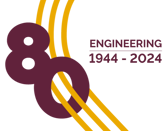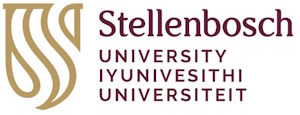
The Faculty of Engineering building, constructed in the 1970s, was originally built when it was assumed that South Africa would adopt the British standard for square power outlet plugs (UK Type G). However, South Africa opted for round power plugs (SA Type M), which are still in use today. So, what’s the best part about the recent Electrical & Electronic (E&E) Engineering building renovations? No more hunting for adapters to fit those square plugs!
On a more serious note, the E&E building renovations are not just a facelift but a complete rejuvenation, says Prof Herman Engelbrecht, Chair of the Department. “A significant part of the refurbishment involved adding more staircases to ensure the E&E building complies with current health and safety regulations,” he explains. The updated building now includes various meeting rooms and breakaway areas to support both collaborative work and quiet, focused tasks. Additionally, colourful wallpapers have been added throughout to bring inspiration and vibrancy to the space.
The only areas left untouched are the undergraduate laboratories (on the second and fourth floors), the Electrical Machines Laboratory (refurbished by mid-2020), the newly built Japie van Zyl area for final years (completed in 2022), and the bathrooms, also previously refurbished.
The building’s transformation includes several significant enhancements across its floors, designed to support the evolving needs of students and faculty. Here are the main changes:
First floor (ground floor):
- Electronic Systems Laboratory (ESL): The ESL, where South Africa’s first satellite (SUNSAT) was designed and built, has moved to the northern side. The new ESL includes a dedicated workshop, aeronautics laboratory, environmental laboratory, shared offices and open-area seating for postgraduate students. This move made space for two new large lecture halls with 138 and 294 seats respectively.
- Café: Chalkboard has temporarily relocated to E&E’s ground floor during the refurbishment of the General Engineering Building.
- Power Electronics research area: Refurbished to include a dedicated laboratory with heavy current (32A power sockets), a new transformer and a motor store for additional heavy machinery storage.
Second floor:
- Undergraduate laboratories: South side laboratory now has environmental control to manage summer temperatures.
- Lecture halls: Refurbished existing hall and a new hall with 184 seats, totalling three new halls with 616 seats.
- Cryogenics laboratory: New facility for experiments with superconducting electronic circuits.
- Research areas: Dedicated spaces for the Electromagnetics and Microwave, Antenna and Computational Systems (EMACS) and Superconductivity, Advanced Materials and NanoDevices (SAND) research groups.
- Workshops: Completely refurbished fine mechanical and electronics workshops, including areas for 3D printing and circuit manufacturing. Technical support staff primarily work here.
- High-Voltage Laboratory Observation Room: Facelift and additional emergency staircase.
Third floor:
- Academic and administrative staff offices: Located on the northern side, along with the main entrance to the E&E department.
- Meeting rooms and breakaway areas: Various spaces for meetings and postgraduate seating for the Energy Research groups.
- Digital Signal Processing (DSP) laboratory: Refurbished lab with a dedicated studio for audio recordings, related to natural language processing research.
- Japie van Zyl area for final years: Built on top of the existing Electrical Machines Laboratory, it includes two lecture halls (Faraday Cage with 54 seats and Watt Room with 90 seats) and a Robotics Laboratory with 50 workbenches. This area supports final-year students in attending lectures and completing capstone projects. *
Fourth floor:
- Undergraduate laboratory (existing): Located on the southern side.
- Offices and postgraduate seating: Northern side includes additional offices for academic staff, open-area seating for postgraduate students, a server room, storage areas, smaller meeting rooms (convertible to a larger room) and a large kitchen and breakaway area for social events.
Fifth floor:
- Antenna and RF Electronics Laboratory: A new steel staircase for roof access and a small elevator for transporting large antennas were added to the previously refurbished Antenna and RF Electronics Laboratory, which includes the anechoic chambers.
The extensive renovations to the E&E building have breathed new life into the Faculty of Engineering, aligning its facilities with the cutting-edge research and high-quality education it is known for.
* The Japie van Zyl area for final years honours the late Dr Japie van Zyl, who can be regarded as one of the Faculty’s most distinguished and outstanding alumni. Dr van Zyl obtained a Hons BEng in Electrical Engineering cum laude at Stellenbosch University (SU) in 1979, an MS in Electrical Engineering (1983), and a PhD in Electrical Engineering (1986) at the California Institute of Technology, Pasadena, USA. He then joined the Jet Propulsion Laboratory (JPL) as a researcher. Dr Van Zyl was named Global Young Engineer of the Year by the International Institute of Electrical and Electronic Engineering in 1997, and in 1998 he was recognised as a Fellow, an honour bestowed on less than 1% of the organisation’s members. In 2010, he received the Distinguished Achievement Award from the same organisation for his contributions to the field of radar research. In December 2015, Dr Japie van Zyl received an honorary degree from SU.
Photograph (from left to right, top to bottom)
~ Some spaces feature striking wallpaper.
~ Each boardroom is named after a key concept or component from the world of electrical and electronic engineering.
~ One of the breakaway areas.
~ The Electrical Machines Laboratory has also been equipped with new work benches.
~ All the new lecture halls have their own unique colour schemes.



